Running Your Little Empire-BRITISH LIFE IN INDIA
.[sorry many photos removed by hackers]
Those who went to India remembered it as a place of hard work and recalled sometimes resenting British popular stereotypes of them as having lives of leisure--waited on by servants, spending time in posh clubs, attending balls, riding to hounds. They saw the work of empire as demanding, difficult, and at times dangerous. Numerically "thin on the ground," they often assumed great responsibilities and administered vast territories or supervised numerous underlings.The Indian Civil Service (or ICS) provided the men who governed India. Graduates of British universities who had passed an examination and interviews and then undertaken a year of training in England, most eventually worked as district officers, virtual rulers of the several hundred districts which were basic administrative units. Assisted by perhaps a few other Europeans as well as Indian officials and clerks, they might render legal decisions, determine land tenure, oversee local police, recommend public works projects, provide famine relief when necessary, even hunt leopards or tigers which menaced villagers. Their power and prestige were such that they were jokingly called "the heaven born" and likened to the Brahmans who stood at the top of the Indian caste system.
[2]ALSO READ:-Beating the heat and ruling the country-ENGLISH MAN'S LIFE IN INDIA:-http://pazhayathu.blogspot.in/2012/04/beating-heat-and-ruling-country-english.html
[3] ALSO READ BLOG:-TYPICAL ENGLISH BUNGALOW:-http://oldphotosbombay.blogspot.in/2010/06/typical-english-bungalow-see-bombay.htmlOther men assumed administrative positions in such organizations as the Forest Service, which cared for great jungle preserves; the Education Service, which ran schools; the Survey of India, which mapped the subcontinent; the state-owned railways; the Police; and the Political Service (made up of already-experienced officers from the ICS or the Army), which dealt with the Indian princes who ruled large portions of India under British oversight (they also staffed British consulates in parts of China and Persia and helped administer the sheikdoms of the Persian Gulf). Others joined commercial enterprises, such as the great trading houses of Calcutta and tea, coffee or jute plantations.
The military life also took many to India. India, in fact, had two large armies. The British Army posted a big part of its strength to India. But there was also the largely separate Indian Army, with British officers and Indian soldiers. Stationed in far-flung cantonments, Army officers worked in support of the civil administrators in maintaining control and engaged in the intermittent warfare which broke out in such areas as the Northwest Frontier, where potentially rebellious tribesmen kept the region unsettled.
Official India was virtually all male, but wives would often play major roles in their husbands' work, touring with them, ministering to local needs, and discovering local problems. Women might also lead more independent lives in mission work or in healing professions.
The young Maharajah of Bastar with his British guardians; photograph courtesy of the Centre of South Asian Studies, University of Cambridge; 1937.
A significant portion of India continued to be ruled by Indian princes under indirect British control. When a minor ascended to a princely throne or if there was gross mismanagement or scandal in a princely state, a British official would be given more direct control. But normally a rajah or nawab had considerable independence to administer his own dominions under the influence of a British Resident or Political Agent.
Running Your Little Empire
Those who went to India remembered it as a place of hard work and recalled sometimes resenting British popular stereotypes of them as having lives of leisure--waited on by servants, spending time in posh clubs, attending balls, riding to hounds. They saw the work of empire as demanding, difficult, and at times dangerous. Numerically "thin on the ground," they often assumed great responsibilities and administered vast territories or supervised numerous underlings.The Indian Civil Service (or ICS) provided the men who governed India. Graduates of British universities who had passed an examination and interviews and then undertaken a year of training in England, most eventually worked as district officers, virtual rulers of the several hundred districts which were basic administrative units. Assisted by perhaps a few other Europeans as well as Indian officials and clerks, they might render legal decisions, determine land tenure, oversee local police, recommend public works projects, provide famine relief when necessary, even hunt leopards or tigers which menaced villagers. Their power and prestige were such that they were jokingly called "the heaven born" and likened to the Brahmans who stood at the top of the Indian caste system.
Other men assumed administrative positions in such organizations as the Forest Service, which cared for great jungle preserves; the Education Service, which ran schools; the Survey of India, which mapped the subcontinent; the state-owned railways; the Police; and the Political Service (made up of already-experienced officers from the ICS or the Army), which dealt with the Indian princes who ruled large portions of India under British oversight (they also staffed British consulates in parts of China and Persia and helped administer the sheikdoms of the Persian Gulf). Others joined commercial enterprises, such as the great trading houses of Calcutta and tea, coffee or jute plantations.
The military life also took many to India. India, in fact, had two large armies. The British Army posted a big part of its strength to India. But there was also the largely separate Indian Army, with British officers and Indian soldiers. Stationed in far-flung cantonments, Army officers worked in support of the civil administrators in maintaining control and engaged in the intermittent warfare which broke out in such areas as the Northwest Frontier, where potentially rebellious tribesmen kept the region unsettled.
Official India was virtually all male, but wives would often play major roles in their husbands' work, touring with them, ministering to local needs, and discovering local problems. Women might also lead more independent lives in mission work or in healing professions.
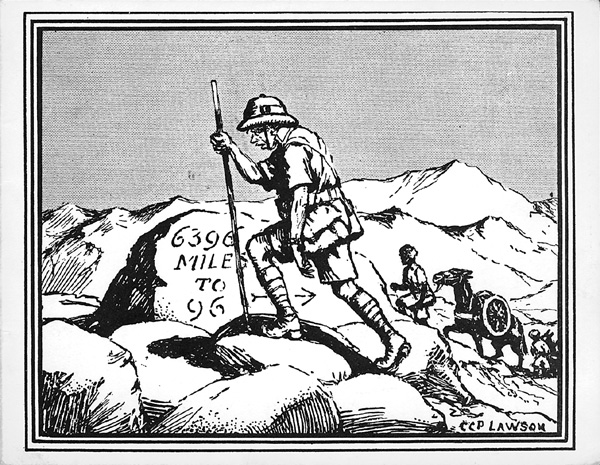 Christmas card produced for members of the Junior Naval and Military
Club; 1930s. "96" refers to club's London address; the card refers to
distant imperial postings of many members, such as this "gunner"
(Royal Artillery officer) depicted with his Indian mountain battery
on the Northwest Frontier.
Christmas card produced for members of the Junior Naval and Military
Club; 1930s. "96" refers to club's London address; the card refers to
distant imperial postings of many members, such as this "gunner"
(Royal Artillery officer) depicted with his Indian mountain battery
on the Northwest Frontier.
Wife of an ICS officer on tour in Surat; photograph courtesy of the Centre of South Asian Studies
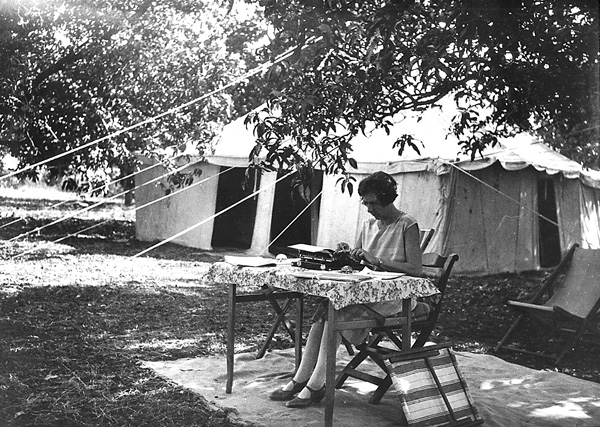 , University of Cambridge; 1929.
, University of Cambridge; 1929.
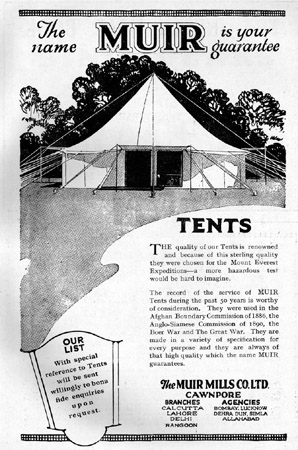 Advertisement for tents in the Hoghunter's Annual (Calcutta) for
1930.
Advertisement for tents in the Hoghunter's Annual (Calcutta) for
1930. Tents were an essential ingredient of English life in India. Officials, particularly district officers, commonly spent a significant part of the year "on tour," traveling around the areas of which they were in charge, listening to residents, dispensing decisions, and inspecting conditions. The tents were often commodious and a touring official might have virtually a multi-room canvas house; they were taken down by servants in the morning and sent ahead to the next camp site and set up, ready for the officer's arrival; such conveniences as portable metal bath tubs would be carried along.
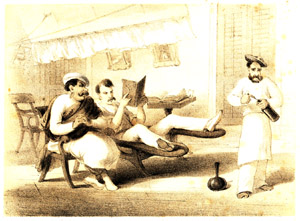 "Our
Moonshee," lithograph in Curry and Rice on Forty Plates by
George Francklin Atkinson; 3rd edition (London: Day and Son, 1859?).
"Our
Moonshee," lithograph in Curry and Rice on Forty Plates by
George Francklin Atkinson; 3rd edition (London: Day and Son, 1859?).
Because they needed to conduct business in Indian languages, British soldiers and administrators labored to acquire local vernaculars, through the aid of a munshi or language instructor. Atkinson's lithographs depict with dry humor life in a "typical" English "station" in the second half of the 19th century.
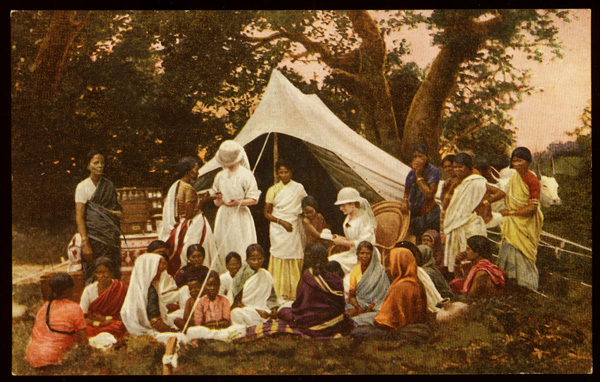 "A
Doctor's Travelling Tent"; color postcard ( London: All-British
Picture Co., Ltd.; no. 9 in the "Indian Medical" series); 20th century.
"A
Doctor's Travelling Tent"; color postcard ( London: All-British
Picture Co., Ltd.; no. 9 in the "Indian Medical" series); 20th century.
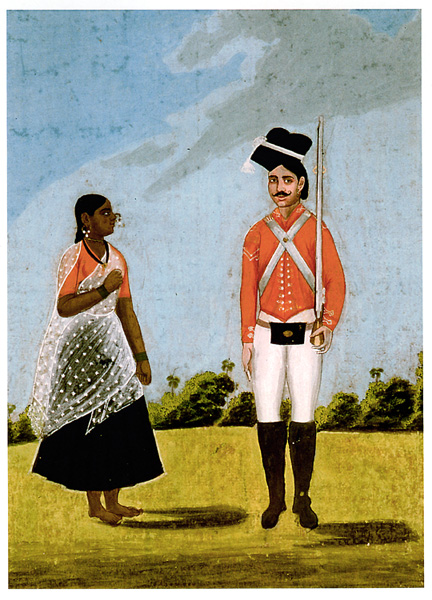 Indian sepoy (infantryman) and his wife; Company School painting,
South India, Tanjore artist; late 18th century.
Indian sepoy (infantryman) and his wife; Company School painting,
South India, Tanjore artist; late 18th century.
From an early period the East India Company raised its own army, which evolved into the Indian Army.
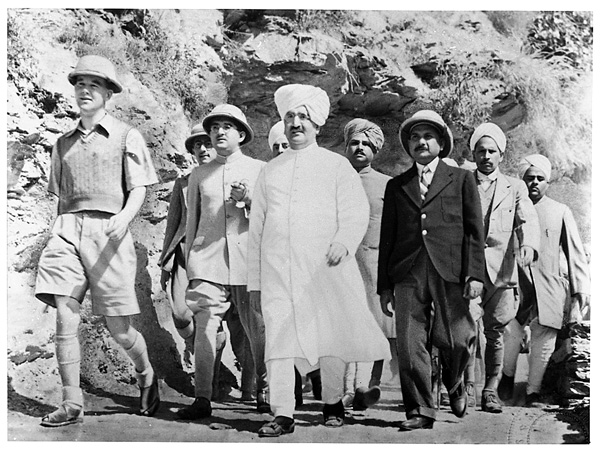 The youthful Superintendent of the Hill States inspecting
with local Indian officials; photograph courtesy of the
Centre of South Asian Studies, University of Cambridge; 20th century.
The youthful Superintendent of the Hill States inspecting
with local Indian officials; photograph courtesy of the
Centre of South Asian Studies, University of Cambridge; 20th century.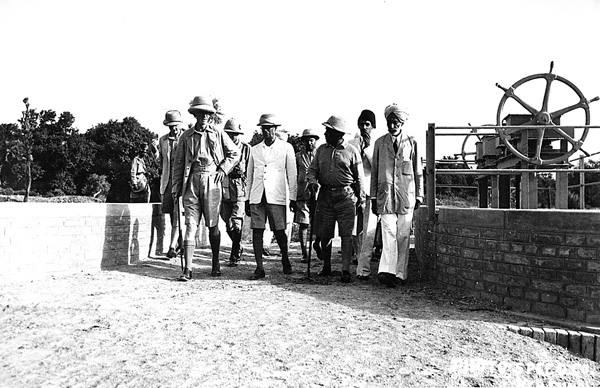 The Governor of Sind inspecting a canal project; photograph courtesy of
the
Centre of South Asian Studies, University of Cambridge; 20th century.
The Governor of Sind inspecting a canal project; photograph courtesy of
the
Centre of South Asian Studies, University of Cambridge; 20th century.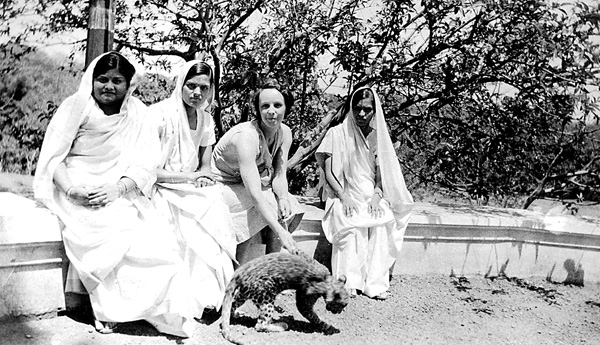 Wife of Indian Political Service member visiting women of the royal
family of a princely state under her husband's direction; photograph
courtesy of the
Centre of South Asian Studies, University of Cambridge; 1920s.
Wife of Indian Political Service member visiting women of the royal
family of a princely state under her husband's direction; photograph
courtesy of the
Centre of South Asian Studies, University of Cambridge; 1920s.
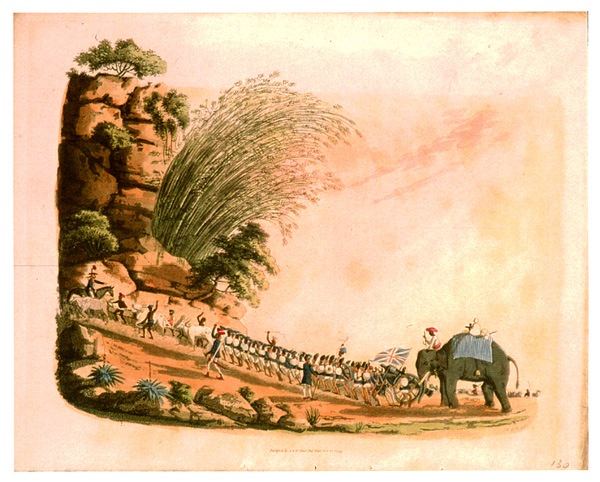 "An Artillery Elephant on Duty"; hand-colored lithograph by Captain C. Gold; 1799.
"An Artillery Elephant on Duty"; hand-colored lithograph by Captain C. Gold; 1799.
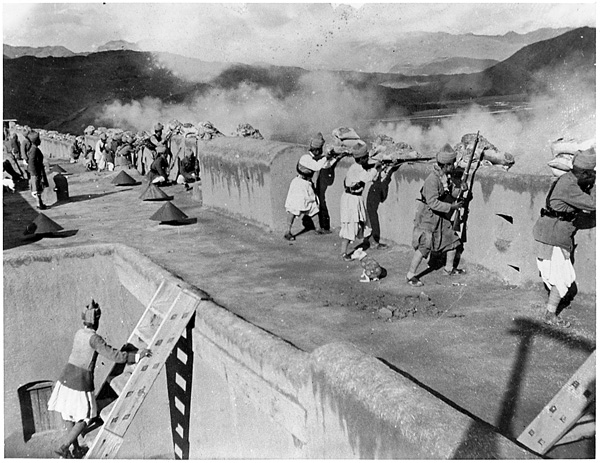 Practice firing from
the walls of a fort on the Northwest Frontier; photograph courtesy of the
Centre of South Asian Studies, University of Cambridge;
20th century.
Practice firing from
the walls of a fort on the Northwest Frontier; photograph courtesy of the
Centre of South Asian Studies, University of Cambridge;
20th century.
The Frontier was the loosely controlled area between British India and Afghanistan inhabited by various tribal groups. The British and Indian armies frequently operated in the region to maintain order and their small campaigns provided what was considered valuable military experience for the troops.

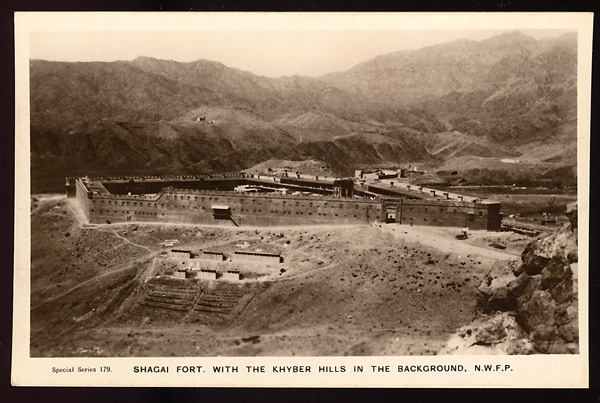 Operations and fortifiations on the Frontier: "Convoy of A.T.
Carts from Paiaza. 100 Yds. Above the Barrari Tangi"; postcard (Simla:
Army Canteen Board), 20th century; "Shagi Fort.
With the Khyber Hills in the Background. N.W.F.P."; postcard
(Peshawar: K.C. Mehra & Sons), 20th century.
Operations and fortifiations on the Frontier: "Convoy of A.T.
Carts from Paiaza. 100 Yds. Above the Barrari Tangi"; postcard (Simla:
Army Canteen Board), 20th century; "Shagi Fort.
With the Khyber Hills in the Background. N.W.F.P."; postcard
(Peshawar: K.C. Mehra & Sons), 20th century.
Two Ensigns of he Royal East INdia Volunteers (EIC's private army) kneel as the Chaplain consecrates regimental colours. Painting in India House Lib, c. 1799
Robert Clive 1757 Battle at Plassy
Siraj -ud-daula
political map of India in 1800
| political map of India in 1857 |
British photograph of Maharaja
British drawing of Indian labourers
Memsahib in a rickshaw
"Mummy and her Tiger", 1920
20th century: Leader and Sowars
INDIAN PRINCE WITH ENGLISH RULERS
[ Bhairam Deo died in 1891 , leaving a minor son Rudrapratap Deo .During his minority the state was managed by government until January 1908 when the young Raja was installed as Feudatory Chief of Bastar.In 1910 a tribal revolt was occured against the Diwan and British government who ruled over the state.Raja Rudrapratap Deo died in 1921 and his daughter Praphul Kumari Devi ascended the throne in 1922.Later in 1927, she was married to Praphul KumarBhanj Deo,who belonged to the royal family Mayurbhanj of Orissa.Praphul Kumari Devi died in 1936 in London and her elder son Maharaja Pravir Chandra Bhanj Deo 'Kakatiya'ascended the throne in 1936 at a minor age.The famous Maharani hospital at Jagdalur was built in memory of Maharani Praphul Kumari Devi in 1937.Later in 1941, the Air strip had been made at Jagdalpur.One bridge was also constructed during this time over river indravati.In 1948, Bastar state has been merged in Indian Union.
Munshi (language teacher) instructing new arrival
Life in the Bungalows
Recollections of English domestic life in India present a picture of an existence both contented and full of difficulties, both luxurious and spartan. Britons generally occupied commodious bungalows (the word itself comes from Indian terminology meaning something from Bengal and referred to a particular housetype originally from that province) and commonly employed numerous servants to run the household.Yet even into the 1940s the house would not have electricity, running water, refrigeration; it would have been open enough for insects, rats, snakes and--in remote areas--even wild animals to invade. Moves to new postings were frequent and thus life was unsettled. It was thought important to send children home to England for schooling, so that family members were separated. There were likely few other Europeans nearby, so that people--especially wives with no official work, possibly no children at home, and only a menage of servants to interact with all day--might feel very isolated. Indeed, women who found outside interests--whether their husbands' work, local charitable pursuits, or the outdoor life--were thought to be happiest.An establishment which was an Indian version of an English country estate was an ideal striven for by earlier British sojourners in India, few of whom could have ever achieved anything so ambitious in England.
Postcards depicting household servants; produced by both Indian publishers, such as Moorli Dhur and Sons of Ambala, and British, such as Higginbotham and Company of Madras and Bangalore; early 20th century.
The great profusion of cards reflects the great profusion of servants: a syce to care for the horses which virtually every sahib maintained; the ayah to care for young children; the sweeper, who maintained latrines and removed "night soil"; the dhurzi, more of a subcontractor than a servant, who would come and sit in a European house for days at a time doing the sewing. The bearer was a man's personal servant who would run the household of a bachelor sahib.
Sahibs and memsahinbs were especially intrigued by the dhobi or laundryman, who supposedly accorded unspeakably harsh treatment to their clothes to get them clean. Being able to employ an impressive number of servants -- far more than could have been afforded in England -- was an attraction of Anglo-Indian life (though many Britons professed their large households to be a mixed blessing).
Englishman being shaved by servant; postcard (Madras and Bangalore: Higginbotham and Company); early 20th century. Being shaved, even while still half asleep, epitomized for some the luxury of Indian servants. Even working-class British soldiers stationed in India would employ Indians to shave them while they still slept in their barracks bunks. The chair depicted here is a planter's long-sleever, the arms extended to provide a foot rest.
"Comic" postcards depicting the foibles of Indian servants--the lazy bearer who rests when his employer is away; the punkah-wallah who nods off when he is supposed to be awake pulling the rope that works the fan which cools his sleeping sahib (Madras and Bangalore: Higginbotham and Company); early 20th century.
"Inoculation against the Plague, Bombay"; "Military Cemetery, Dagshai, India"; postcards; early 20th century. From early days the British saw India as a place of danger and early death, especially due to disease.
No More India to Go to:
Departure and Connections
The process by which Britain disengaged from political control of India was a long and arduous one. Though reaction against British rule was periodic, Indian nationalism evolved in the latter half of the 19th century, a process stimulated by the creation of the Congress Movement (actually founded by an Englishman) in 1885, as Indians increasingly opposed being ruled by a foreign power. The march to Independence involved protracted political maneuvering, various reforms, visiting British delegations, much debate and discussion, repressions, mass demonstrations, and -- in some places -- riots and terrorism. Mohandas K. Gandhi emerged as the guiding force of the independence movement. The Second World War weakened the power of the British Empire and a post-war Labour government in London undermined the dedication to empire. The decision was made by the British government to prepare for the independence of India, though two separate nations emerged -- Hindu India and Muslim Pakistan -- as did violence between religious groups.Most of the British in India returned home to retirement or new lives. Some "stayed on" in various capacities, but the old system which had sent Britons to India as colonial rulers had ended forever and with it a unique mode of life. Those who spoke of this end spoke of it with a mixture of regret, good will, recognition of the inevitable, and pleasure in on-going ties to the new nations.
Beyond personal ties, however, were the cultural ones which had grown up over the course of more than two centuries. India obtained the English language -- indeed, created a distinct version of English -- a factor which had a profound influence upon the writing and literature of the subcontinent. The English language, on the other hand, borrowed numerous words from Indian languages (pajama, jungle, coolie, bungalow, kabob). More importantly, the Indian connection gave English literature a milieu dissected and projected by numerous British writers -- Kipling, Forster, Paul Scott, George Orwell, Rumer Godden. British landscape artists -- Edward Lear, Sir Charles D'Oyly, William and Thomas Daniell -- were attracted to India to create vivid images that introduced Europeans to the physical shape -- both natural and cultural -- of the great subcontinent. The tradition of Indian miniature painting adapted itself to a British market. European style buildings sprouted all over India, while British architects adapted Indian styles for use both in India and Britain. British dominance brought about many changes in Indian life, while the Indian connection made a lasting impact upon British popular culture. Indeed, India became ingrained in British consciousness -- as an image, as a place where friends or family members lived, as a symbol of British power. Since the Second World War, there has been a mass influx of Indians and Pakistanis into Britain -- a development enabled by former imperial connections -- so that today, perhaps ironically, many more people from the subcontinent live in England than Britons ever lived in India. In many ways these Asians are now transforming British life.
Family photo album; 1920s-1930s
Camp Coffee bottles; 1970s.
Labels for commercial products, such as this one of a British officer in camp in India with his Sikh orderly, reminded Britons of the Indian connection. That the label persisted into the 1970s suggests the enduring appeal of India for the British.
"India: The Imperial Cadet Corps, Composed Only of Indian Native Princes," cigarette card from another series, "Allied Cavalry"; issued by John Player and Sons; c. 1918.
Thomas Daniell and his uncle William were among the most successful of the British artists who visited India over the years, producing paintings and prints which conveyed to those at home what India looked like and which gave the Indian landscape a role in British art. The Daniells were in India 1794-96 and published dozens of aquatints in portfolios such as Oriental Scenery.
This plate combines two aquatints by the Daniells, one of a Calcutta street, the other of a sacred tree in Bihar, to create a single image. Pottery with Indian motifs was another factor in bringing India to the British public.
Because they wanted souvenir images of the India they knew, Britons in India began to patronize Indian artists who could provide them. Thus there arose the "Company School" of miniature painting, so called because the pictures were originally produced for employees of the East India Company. Though they drew upon a long tradition of miniature painting in India, the painters adapted their style for European consumption. The subtleties of the earlier traditions were sacrificed to produce fairly simple illustrations of a limited range of Indian life which the British encountered. Thus the Company paintings provided what was in some ways a restricted vision.
The mounting, decorations and labeling indicates that these images were parts of albums, probably brought home to England from India. Company School paintings tended to focus on a simple range of representative crafts and occupations, castes and ethnic groups, and commonly observed events and occasions.
"Khansamah Followed by Coolie Bringing Home the Provisions for the Day," Company School painting, Patna artist; c. 1880.
"Basket Makers," Company School painting by Bani Lal of Patna; c. 1880.
"Mysore Government Offices, Cubbon Park"; "Oilette" postcard (London: Raphael Tuck and Sons; c. 1910; "View of Calcutta from the Esplanade," steel engraving; 1850s (?), later hand coloring. Especially in the cities they founded, like Madras and Calcutta, but elsewhere as well, the British imposed European architectural styles.
In this engraving the European woman and child in the center appear to be engulfed by Indian humanity, but they in turn are dominated by the severe lines of the European structures in the near distance.
"Municipal Building" and "Victoria Terminus," photographs in a souvenir portfolio, "Views of Bombay"; late 19th century.
By the end of the 19th century British architects were mingling European and Indian styles in the structures they designed in India.
"The Legislative Buildings, Delhi (India)" and "The Secretariats of the Government of India," tear-out postcards (Delhi: H.A. Mirza and Sons); c. 1912.
By the time the British built New Delhi -- out of a desire to move their capital from Calcutta to a more central and more historically symbolic place -- the British had developed a style of architecture that fused Western and Indian features.
"The Royal Pavilion, Brighton," postcard (Brighton: A.W.W.); c. 1910; "North Gate, Pavilion, Brighton," postcard from a watercolor by W.H. Borrow (London?: Water Colour Post Card Co.); c. 1900; British structures influenced by Indian architecture, in Apollo, August 1970.
Indian architectural features also found their way into British buildings, most notably into the fantasy Royal Pavilion in Brighton, rebuilt in this style after 1817 for George IV when Prince of Wales. However, Indian influence can be seen in many other buildings.
"Court of Honour, Franco-British Exhibition, London, 1908," postcard published by Bonnett and Shum; 1908;
"The Lake by Night, British Empire Exhibition, Wembley," color postcard published by the Photochrom Co.; 19xx.
Vast exhibitions showcasing European overseas empires not only brought Indian architecture to England but played a major role in further building popular awareness of India.
Life of leisure, massacre, extortion, servants, luxury, it is not surprising that some are nostalgic for that exploitative past.
Traveller's Bungalow in India, Antique British Raj Lithograph
..........................................................................................................................
"It was twenty-one days' march from one end of the district to the other, five thousand square miles. That was quite a lot of ground to cover."
- Philip Mason, who joined the Indian Civil Service in 1928 and served as a district officer and in the central government
Running Your Little Empire
Those who went to India remembered it as a place of hard work and recalled sometimes resenting British popular stereotypes of them as having lives of leisure--waited on by servants, spending time in posh clubs, attending balls, riding to hounds. They saw the work of empire as demanding, difficult, and at times dangerous. Numerically "thin on the ground," they often assumed great responsibilities and administered vast territories or supervised numerous underlings.The Indian Civil Service (or ICS) provided the men who governed India. Graduates of British universities who had passed an examination and interviews and then undertaken a year of training in England, most eventually worked as district officers, virtual rulers of the several hundred districts which were basic administrative units. Assisted by perhaps a few other Europeans as well as Indian officials and clerks, they might render legal decisions, determine land tenure, oversee local police, recommend public works projects, provide famine relief when necessary, even hunt leopards or tigers which menaced villagers. Their power and prestige were such that they were jokingly called "the heaven born" and likened to the Brahmans who stood at the top of the Indian caste system.
Other men assumed administrative positions in such organizations as the Forest Service, which cared for great jungle preserves; the Education Service, which ran schools; the Survey of India, which mapped the subcontinent; the state-owned railways; the Police; and the Political Service (made up of already-experienced officers from the ICS or the Army), which dealt with the Indian princes who ruled large portions of India under British oversight (they also staffed British consulates in parts of China and Persia and helped administer the sheikdoms of the Persian Gulf). Others joined commercial enterprises, such as the great trading houses of Calcutta and tea, coffee or jute plantations.
The military life also took many to India. India, in fact, had two large armies. The British Army posted a big part of its strength to India. But there was also the largely separate Indian Army, with British officers and Indian soldiers. Stationed in far-flung cantonments, Army officers worked in support of the civil administrators in maintaining control and engaged in the intermittent warfare which broke out in such areas as the Northwest Frontier, where potentially rebellious tribesmen kept the region unsettled.
Official India was virtually all male, but wives would often play major roles in their husbands' work, touring with them, ministering to local needs, and discovering local problems. Women might also lead more independent lives in mission work or in healing professions.
Wife of an ICS officer on tour in Surat; photograph courtesy of the Centre of South Asian Studies
Tents were an essential ingredient of English life in India. Officials, particularly district officers, commonly spent a significant part of the year "on tour," traveling around the areas of which they were in charge, listening to residents, dispensing decisions, and inspecting conditions. The tents were often commodious and a touring official might have virtually a multi-room canvas house; they were taken down by servants in the morning and sent ahead to the next camp site and set up, ready for the officer's arrival; such conveniences as portable metal bath tubs would be carried along.
Because they needed to conduct business in Indian languages, British soldiers and administrators labored to acquire local vernaculars, through the aid of a munshi or language instructor. Atkinson's lithographs depict with dry humor life in a "typical" English "station" in the second half of the 19th century.
From an early period the East India Company raised its own army, which evolved into the Indian Army.
The Frontier was the loosely controlled area between British India and Afghanistan inhabited by various tribal groups. The British and Indian armies frequently operated in the region to maintain order and their small campaigns provided what was considered valuable military experience for the troops.
The Frontier Constabulary was a paramilitary force which patrolled part of the Northwest Frontier.
A significant portion of India continued to be ruled by Indian princes under indirect British control. When a minor ascended to a princely throne or if there was gross mismanagement or scandal in a princely state, a British official would be given more direct control. But normally a rajah or nawab had considerable independence to administer his own dominions under the influence of a British Resident or Political Agent.
An Introduction
Acknowledgements
1. The Passage to India | interviews
2. Running Your Empire | interviews
3. Life in the Bungalows | interviews
4. Imperial Diversions | interviews
5. Never the Twain? | interviews
6. No more India to go to | interviews
Great photos. But please don't present the British in India as if on some sort of humanitarian mission--organizing districts, mapping the country, keeping order. Yes, yes, they did this, but only in support of a highly organized system of looting. Districts organized for the sake of control, mapping done to exploit natural resources like coal and create tea plantation, and military and police control not for order but for rule. As Prime Minister Nehru said of the Indian Civil Service, there was nothing Indian about them (the Brits had all the controlling authority), nothing civil, and nothing to do with service. Unless you equate plunder with service. They left India illiterate, impoverished and dispirited.
ReplyDeleteThose are some amazing Pictures! Thank you for sharing.
ReplyDeletePainting from Photo Photo to painting from photo 100% handmade in oil, charcoal, pencil or watercolor paintings from photos are unique personalized gifts by professional portrait artists. All of our portrait artists have degrees in fine art and years of professional experience. Every painting is examined by our senior portrait artists to ensure best quality. We only use premium quality specialized art supplies to create your painting. Contact us for custom made, high quality oil paintings at an affordable cost and quick worldwide delivery that allows you to express your creativity easily and make great art.
ReplyDeleteYour blog provided us with valuable information to work with. Thanks a lot for sharing. Keep blogging.
ReplyDeletedesigner wallpaper suppliers in india
Free classifieds in Hyderabad
ReplyDeleteFree classifieds in Chennai
Free classifieds in Bangalore
Free classifieds in Mumbai
Free classifieds in ahmedabad
Free classifieds in India
Free classifieds in visakhapatnam
Free classifieds in Surat
Thanks for all your efforts that you have put in this. very interesting information. i like with express my support of your ideas in your article, and looking forward to your next article.
ReplyDeletemelt flow index manufacturers
Your post is just outstanding! thanks for such a post,its really going great and great work.Architect Photographer in Bangalore | Catalogue Photographer in Bangalore
ReplyDeleteThis comment has been removed by the author.
ReplyDeleteThe whole writing is utter nonsense. The state of the lower classes of the subcontinent was so terrible, that they had only the native-English officials as a source of help.
ReplyDeleteThey were terribly suppressed by the feudal classes of the land by means of the hammering done by the lower indicant words of the feudal languages of the subcontinent.
The bitter truth is that it was the English rule that saved the lower castes and populations from 100s of years of enslavement.
Check: Shrouded Satanism in feudal languages, for more information.
I Found this blog very informative. keep writing.
ReplyDeleteStock Trading Tips
Interesting post, one can recollect the pre-independence era. You can visit our website @ Properties In South Mumbai.
ReplyDelete